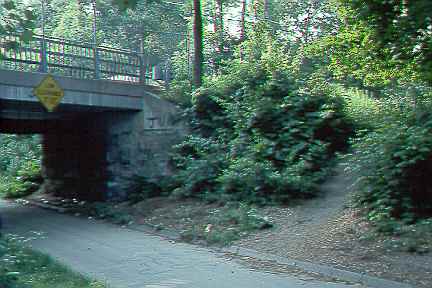
Westfield-Northampton route description
Northampton bicycle path photo tour
Note: this page was not part of the original report. The opinions expressed on this page are entirely the author's own.
The Northampton bicycle path runs east-west across Northampton, . The bicycle path follows an east-west rail line. The rail line continues west to Williamsburg, but the path presently continues only as far as Bridge Street, at the west end of Northampton.
The Northampton path runs parallel to and a few blocks north of Route 9, which has wide lanes and offers no great challenge to an experienced adult bicyclist. The major trip origins and destinations that the path serves are along Route 9, so using the path lengthens most cross-town trips. The primary reason for the location of the path is that the rail corridor was available. The primary logical justification for the path, given all these factors, would be to provide a bicycle facility suitable for children, for recreational riding and as a linear park.
The path is smoothly-paved (as of 1993) and straight, as is usual with paths built on railroad rights of way. Its design apparently reflects guidelines developed locally, and which differ from the AASHTO guidelines for bicycle paths, especially in intersection design.
Most intersections on the path are grade crossings. There is one underpass, at Jackson Street, where path users have worn an unofficial access route down from street level. While this access does not meet AASHTO guidelines, it is probably less hazardous than it seems, because it is obviously unrideable for most bicyclists.

The next photograph shows the grade crossing at Hatfield Road, as seen from the north. The bicycle path crosses the road at a striped pedestrian-type crossing. At the right in the picture, there is a "Bike Xing" warning sign partly obscured by trees. Note also the roads and driveways entering from each side, and the vegetation obscuring sightlines, especially on the far side of the intersection.
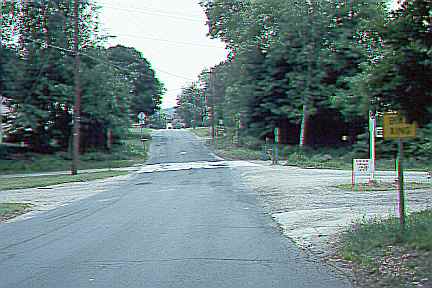
The Northampton path has barriers at every intersection, and at least two barriers where there is no intersection. Bicyclists must pass through a narrow opening, taking care to stay on the pavement.
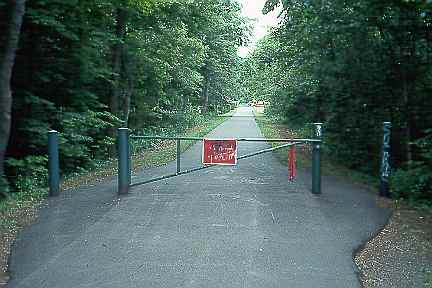
At all intersections, there are stop signs for the bicyclists. At some intersections, there are "Walk Bike Across Intersection" signs.
The common justification for barriers is that they slow bicyclists down. Usually, barriers are ordered by local officials or committees after there have been complaints of bicyclists' speeding across in front of motor vehicles, or a serious car-bicycle collision.
The hazard to slow-walking elderly crossing streets has recently drawn attention the attention of safety advocates. In that light, requiring bicyclists to slow and walk across intersections is clearly contradictory. A pedestrian in a crosswalk is only a foot or two across in profile. A bicycle crossways to traffic is six feet wide. A competent bicyclist can make up for this disadvantage with speed, but not while walking.
The fundamental safety problem for bicyclists in bicycle path-road intersections that of skill in negotiating right of way. This problem can be avoided by grade separations, by traffic signals, by avoiding building bicycle paths where they attract unaccompanied children, and by bicyclist education.
But what laws apply at a bicycle path-road intersection? If it is a crosswalk, then traffic on the road clearly is required to yield, but only to pedestrians once they have entered the crosswalk.
When enforced, this approach works reasonably well for pedestrians, though some municipalities (none yet in Massachusetts) have improved it by requiring drivers also to yield to pedestrians who signal the intention to cross, before they enter the crosswalk.
How does the crosswalk approach work for bicyclists? If we consider the bicyclist to be a pedestrian, then the bicyclist must, according to the law, stop after entering the crosswalk to signal the intention to cross while at the same time giving the motorist time to yield. The bicyclist as pedestrian is not required to stop if there is no cross traffic.
But what if we consider the bicyclist to be a vehicle operator? A stop sign requires a vehicle operator to stop before, not after, entering the intersection. And a stop sign also requires the bicyclist as vehicle operator to yield to cross traffic.
In practice, most motorists will yield to a bicycle which is already in the crosswalk, so the overall effect of the stop sign and crosswalk in combination is that of four-way stop signs. Massachusetts law does not, however, make it clear whether the bicyclist operating on the bicycle path is a vehicle operator or a pedestrian.
A competent bicyclist also knows how to use the bicycle's gears to accelerate smartly. A competent bicyclist, like any competent driver, knows how much it is necessary to slow while approaching an intersection. It is only necessary to slow enough to check for cross traffic and still be able to stop before entering the intersection. Approaching the intersection too fast runs the risk of a collision, but approaching the intersection slower than necessary makes it take the bicyclist longer to clear the intersection and makes it more likely that the bicyclist will have to stop and wait.
Child and novice bicyclists may be more familiar with how to cross as pedestrians than as vehicle operators, but many bicyclists who are not skilled enough to cross while riding are also not skilled enough to cross unassisted on foot. For these bicyclists, mostly children, bicycle path intersections logically ought to be designed as school crossings. That is, traffic in the cross street should be required to yield to the bicyclists. Though motorists are generally required to yield to traffic in a marked crosswalk, yield signs, stop signs or traffic signals may sometimes be appropriate -- not just "Bike Xing" signs.
Adding to this confusion is the generally low level of traffic law against both bicyclists and motorists in Massachusetts.
Barriers at the entrances to an intersection force a bicyclist to slow down when approaching the intersection, but also while in the intersection. Extra delays are imposed not only on the bicyclists themselves, but on motorists waiting for the bicyclists to cross. Barriers make the bicycle path into somewhat of an obstacle course. The photo below shows the exit from a Northampton intersection where a bicyclist must maneuver slowly and carefully to avoid running into a drainage ditch with a raised storm drain cover and signpost. A barrier can cause an accident, whether or not there is any cross traffic.
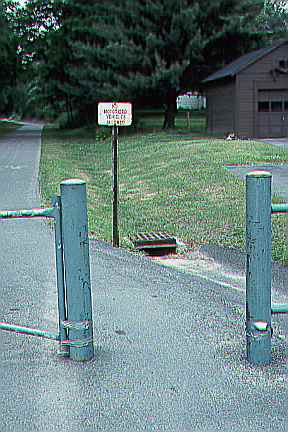
Here is the east end of the path at State Street, as seen from the path.
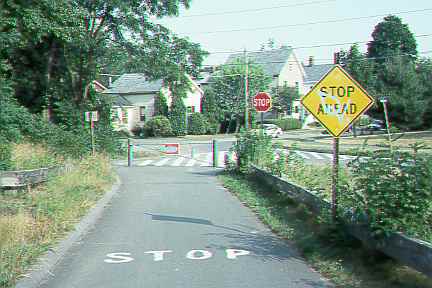 .
.
This is the end of the path as seen from the opposite direction. The crosswalk stripes here apparently reflect an assumption that eastbound bicyclists will cross State Street as pedestrians.

AASHTO bicycle facilities guidelines require a 5 foot opening width and a 50 foot turning radius. The Northampton barriers do not meet these guidelines. The openings in these barriers are barely large enough for an adult tricycle or a bicycle trailer to pass at all.
The effect of intersection barriers on accident rates has not to the author's knowledge ever been subjected to scientific analysis, but it is certainly open to many questions. The main issue again, is that of a bicyclist's skill in evaluating whether it is safe to cross, and that, while it is often necessary to slow to approach unsafely, it is also generally safer (and avoids unnecessary delays) to clear the intersection faster. Barriers slow bicyclists by an arbitrary amount both as they enter and as they leave the intersection; stop signs carry a confusing message if the rules for yielding are in fact those at a crosswalk; "Walk Bike Across Intersection" signs reflect the fundamentally flawed premise that clearing an intersection by walking, which is slower, is safer than clearing it by riding, which is faster.